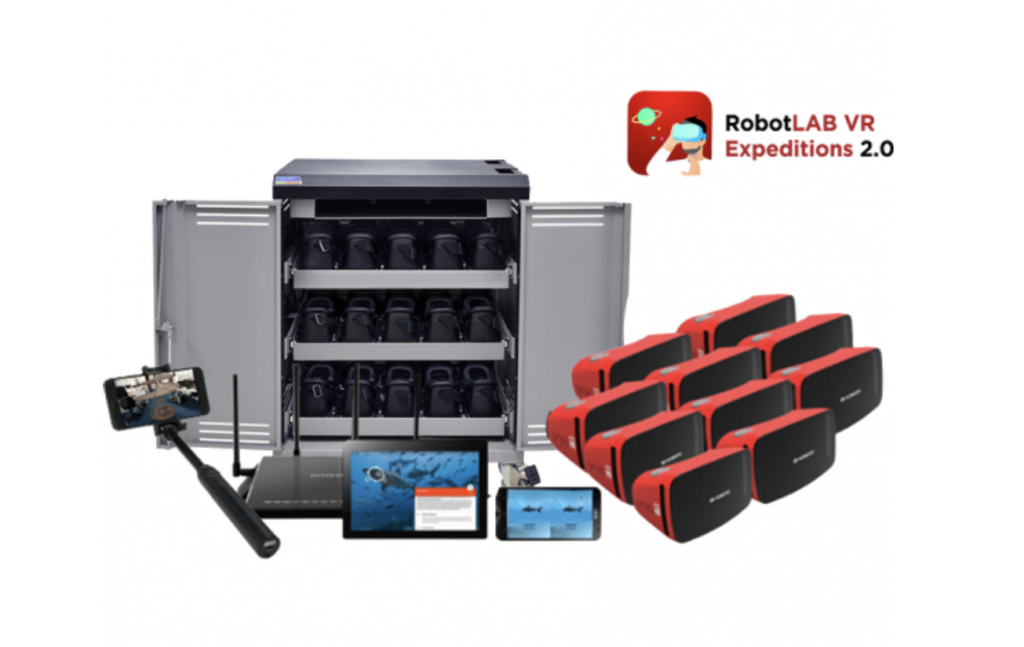A good deal of VR-based instruction took a hit when the Google Expeditions VR solutions were scaled back last summer. Educators are no longer able to access the Google Expeditions app, which is how they would find engaging and immersive lessons, tours, and experiences for students. The good news, however, is that we've taken a big step in securing a replacement option. Within the last couple of weeks, we finalized the addition of the RobotLAB VR Expeditions 2.0 kits to our store! Like the Google Expeditions kits, there are various options when it comes to size, plenty of VR content for students to access, and a bunch of useful accessories included. Hopefully, this will help a lot of educators continue teaching with AR and VR.
Currently, we have six RobotLAB VR kits available on our store. They also run on the expensive side but we believe the value they add to experiential learning is legitimate. Also, like the Google Expeditions kits, some of these solutions have augmented reality capabilities as well as virtual reality. Some are available for 10, 20, or 30 students while others only include the 30-student option except for one 27-pack. And, for accessories, some include a rolling storage cart, a transport case, and teacher materials with different options to choose.
We're now offering three variations of the RobotLAB VR kits. There are the Standard AR/VR kits, the Advanced VR kits, and the Standard VR kits. The Standard VR Kits come with lower-end red VR viewers while the Advanced Kits come with headsets that are more advanced and black in color. The VR Standard kit is available in two options: with a cart or with a rolling case. The option with the cart is more costly to start but the option with the rolling case is available in units of 10, 20, or 30—increasing in price with the added units.
The same is true for the AR/VR Standard Kits: a 30-student kit that comes with a cart or the option to choose between a 10-pack, 20-pack, or 30-pack that comes with a rolling case instead. And, you guessed it, it's the same situation for the Advanced Kits. The 27-Student Advanced Kit is more costly and comes with the cart included while the Advanced Kit includes the rolling case and the option to choose between a 10-pack, 20-pack, or 30-pack. Whatever kit size and style educators choose, they all, however, come with a 1-year warranty and RobotLAB support.
Besides the differences in transport options and number of headsets, both of the Standard VR kits come with a teacher tablet, Wi-Fi router, and a charger (either multi-port or a rapid charger). The Standard AR/VR kits come with the same materials plus the addition of selfie sticks for students to use. And, the Advanced Kits come with student controllers in addition to the headsets and all of the other materials. All kits also come with the RobotLAB Expeditions 2.0 app pre-loaded onto the headsets, making it easier when getting started.
Yes, there's a lot to go over when it comes to each kit's components but, hopefully, that helps educators gain a better understanding of what they'll get with each of them. As for educational value and content, the RobotLAB VR Expeditions 2.0 hardware and software essentially enable educators to take students on immersive VR field trips. In fact, there are over 700 field trips they can access through the app without having to leave the classroom! Plus, the lessons are relevant in all areas of the curriculum from science and history to literature. And, as you might guess, the Expeditions 2.0 app helps educators tie everything together as the centerpiece of these solutions.

The app and content within it each help educators supplement existing curriculum with vivid imagery and up-close interaction. Essentially, they're described as collections of 360-degree panoramas and 3D images that also include annotated and interactive details, highlighted points of interest, and prompts for relevant questions teachers can ask as they lead lessons. These features, combined with the included teacher tablet, help ensure educators integrate the hardware and the VR content effectively. We should also note that, since each RobotLAB VR kit comes with so many valuable accessories and access to user-friendly software, they truly do serve as turnkey learning solutions.
As we've said, two of the RobotLAB VR kits also include augmented reality capabilities. This feature allows educators to switch the Expeditions 2.0 app to AR mode and bring digital content to life in front of students' eyes. While there aren't as many AR expeditions (just over 100), this added dimension helps students better grasp abstract concepts and see things up close. There's also the option for them to create their own VR content if possible. Using the Tour Creator tool, students can access footage from the 360-degree cameras that capture Google Street View content. Then, they can compile it to create their own footage, adding another opportunity for them to truly tap their creativity.
In terms of usage, teachers can easily take control of lessons and lead their students through field trips. This is what enables them to interact with what they've been discussing in recent units. Plus, using the teacher tablet, they can also track what students are viewing to ensure they're on task. And, teachers can pause trips at any time, pipe in sounds to make the experience more realistic, or let students go off on their own expeditions once they're ready. All of this and more is possible with the RobotLAB VR Expeditions 2.0 systems! If you have any questions about these solutions, please feel free to contact us. And, to place and order or request a quote, click below to get started. Follow us on Twitter and Instagram for more.








2 Comments